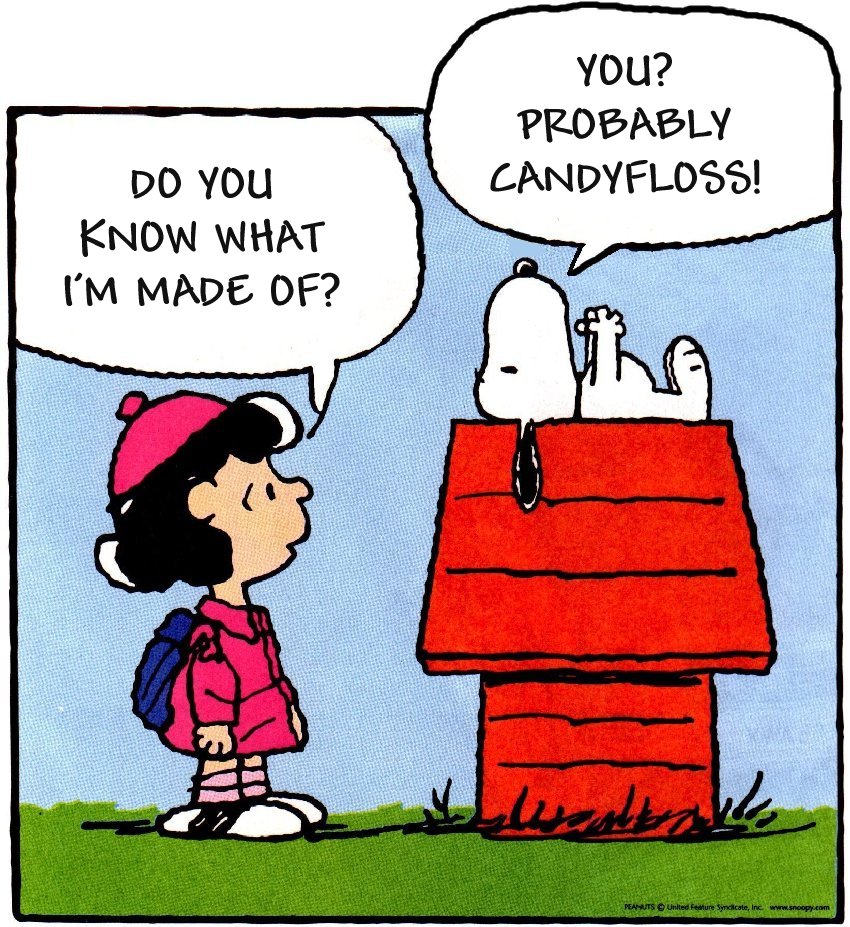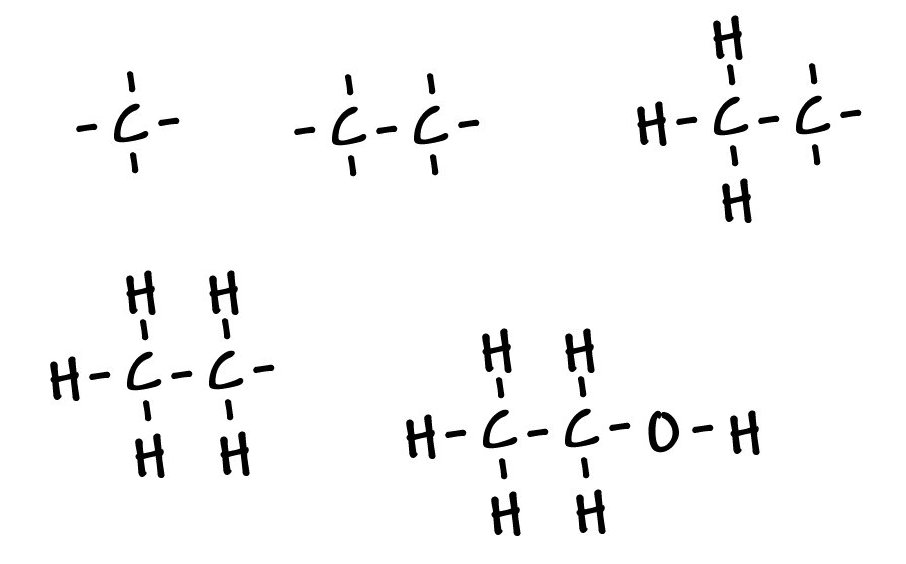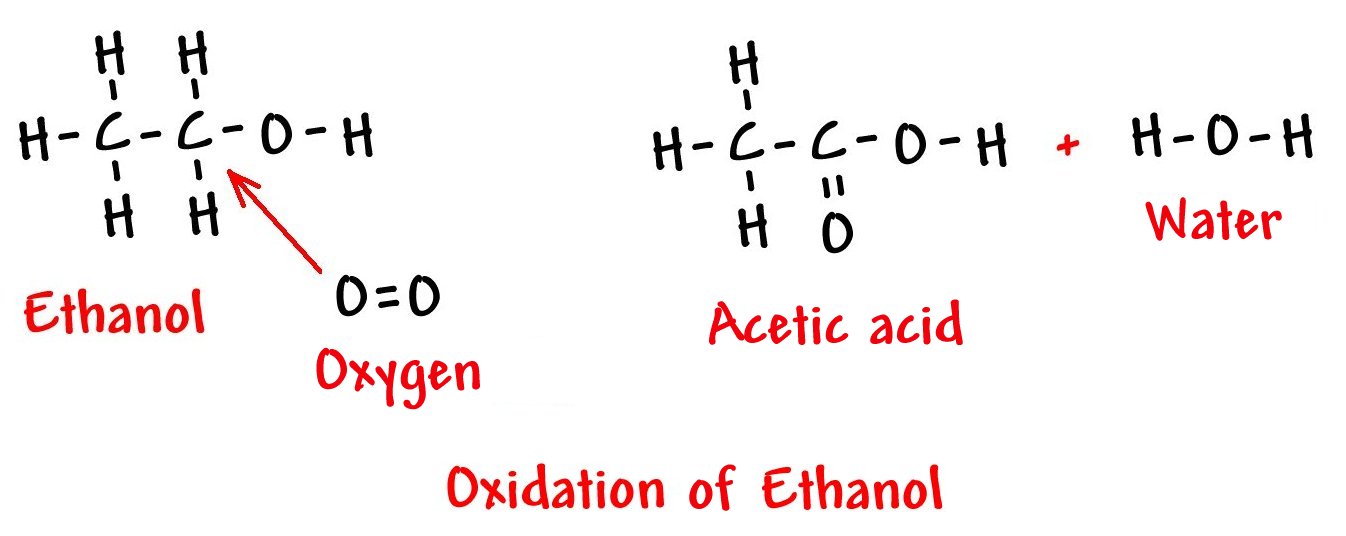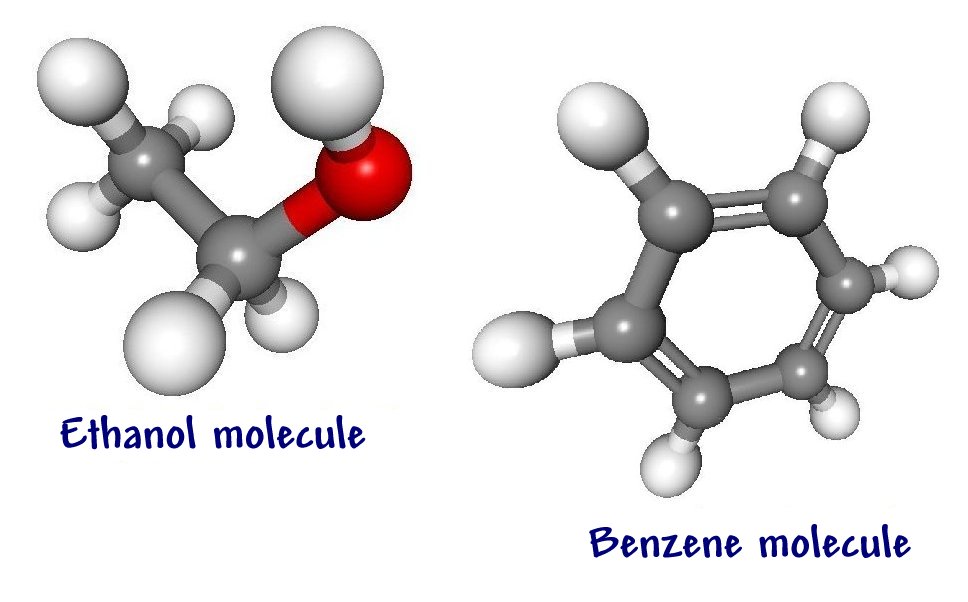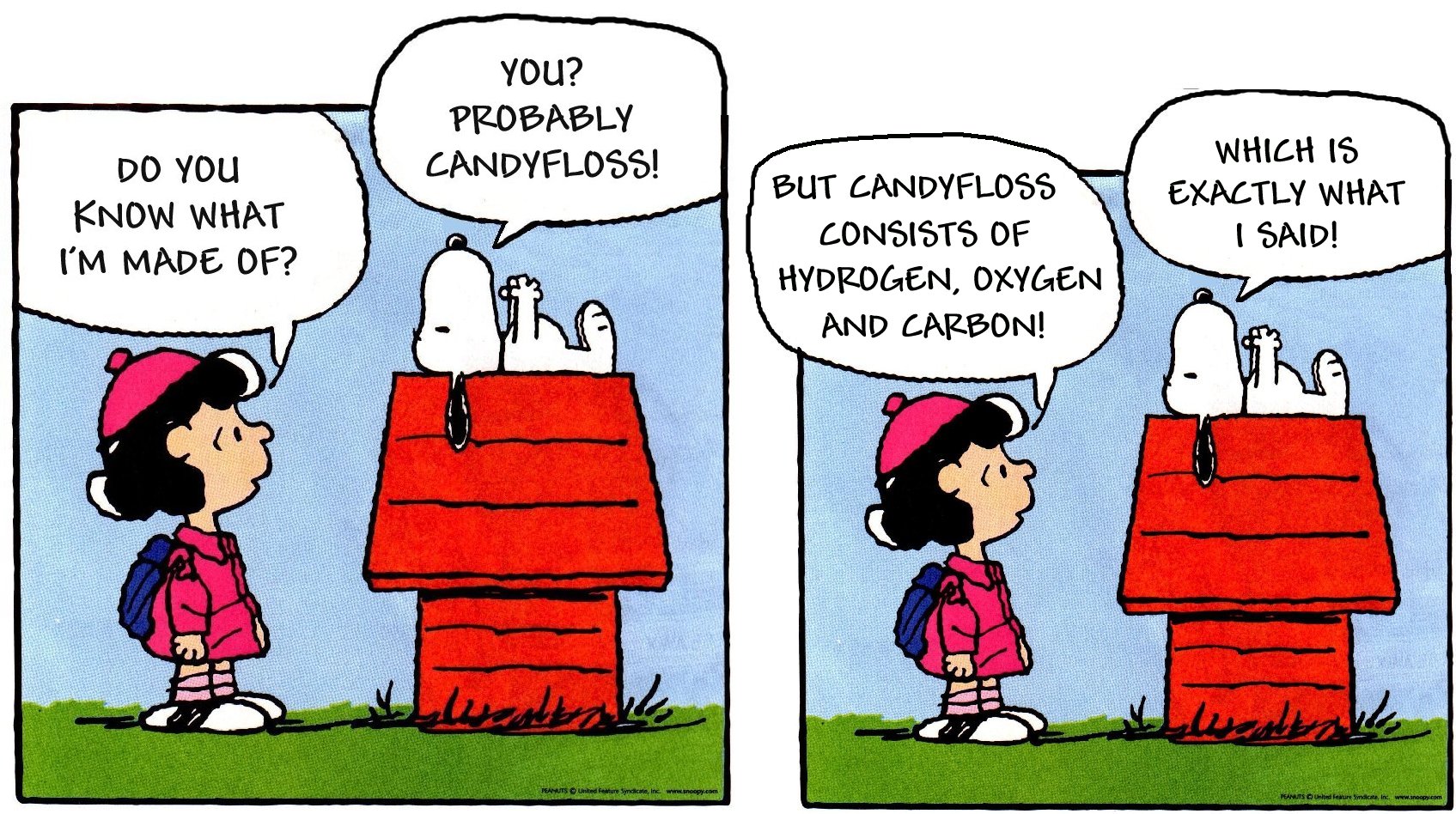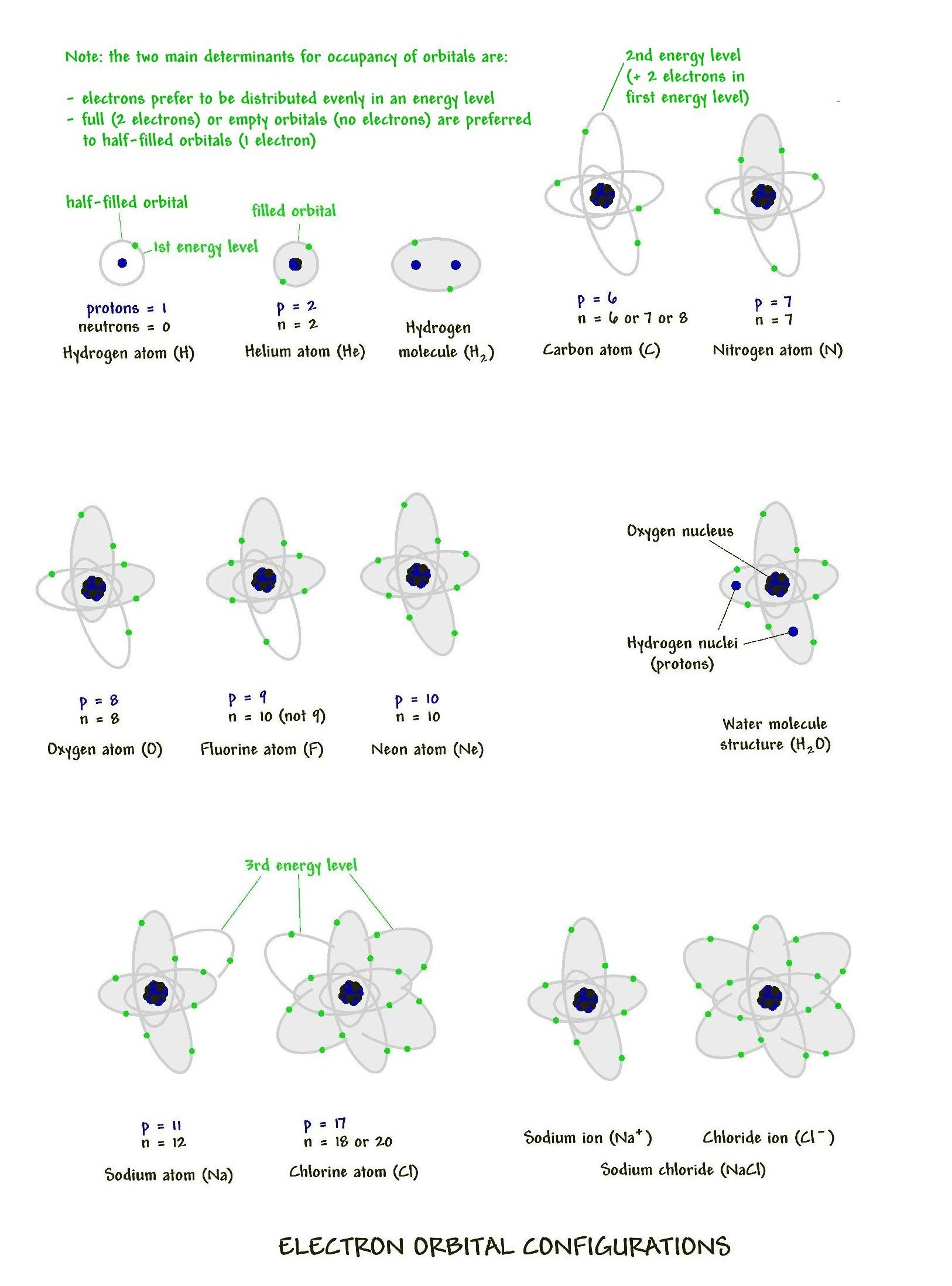DIE
ELEMENTE VON LEBEN
Aus
was besteht ihr? Überraschend, das meiste von eurem Körper ist aus . .
. Wasser. Das ist, weil die meiste von den Zellen in Lebensformen
Wasser enthalten. Das andere Hauptelement, das sich in Lebensformgewebe
befindet, ist Kohlenstoff. Wasser besteht aus den Elementen Sauerstoff
und Wasserstoff. Mit anderen Worten, fast alles eures Körpers ist aus
Wasserstoff, Sauerstoff und Kohlenstoff.

Es
gibt etwa 100 Elemente, die natürlich vorkommen, einschließlich Calcium
und Phosphor, die wir in Knochen und Zähnen finden, aber das meiste vom
Universum besteht aus Wasserstoff, aus dem die Sterne bestehen. Der
Reihe nach bestehen aus subatomaren Teilchen die Atome aller Elemente.
Diese sind Protonen, Neutronen und Elektronen. So können wir sagen,
dass alles das im Universum existiert – ihr einbezogen – aus diesen
drei Teilchen besteht.
Wasserstoff
ist das einfachste Element.
Ein Wasserstoffatom besteht aus einem einzigen Proton – seinem Kern –
und einem einzigen Elektron, das den Kern umkreist. Das Proton ist
elektrisch positiv geladen und das Elektron negativ, so dass die Lasten
sich ausgleichen.

In
den Atomen der anderen Elemente enhält der Kern Protonen und Neutronen
(die letzteren haben keine elektrische Last) und ist von einer Wolke
von umkreisenden Elektronen umgeben. Die Nummer von Elecktronen kommt
immer der Nummer von Protonen gleich, so dass das Atom elektrisch
neutral ist. Die Elektronen kreisen in verschiedenen Energiestufen um
(seit den Anhang).
In
einem
Kohlenstoffatom gibt es sechs Protonen und sechs oder sieben oder acht
Neutronen im Kern und sechs umkreisende Elektronen, zwei in der ersten
Energiestufe und vier in der zweiten. In einem Sauerstoffatom gibt es
acht jedes Teilchens.
Wenn
sich Atome verbinden, wechseln sie
ihre Elektronkonfiguration, um Moleküle zu formen. Ein
Wasserstoffmolekül ist nur zwei Wasserstoffatome durch ihre Elektronen
zusammen verbunden. Ein Wassermolekül ist aus einem Sauerstoffatom mit
zwei Wasserstoffatomen verbunden.

Manchmal
sind die Atome mit Elektronenteilen verbunden, wie in dem
Wasserstoffmolekül und Wassermolekül oben beschrieben. Wie wir schon
wissen, hat das Kohlenstoffatom sechs Elektronen, dessen vier
erhältlich sind, um chemische Bänder zu formen. Manchmal spenden einige
Atome ihre Elektronen für andere Atome, was bedeudet, dass einigen
Atomen ein Elektron fehlt und sie daher positiv geladen sind, und
einige ein zusätzliches Elektron haben und daher negativ geladen sind.
In diesen Molekülen werden die Atome von electrischer Anziehungskraft
zusammen gehalten. In Häufigsalz, zum Beispiel, spendet jedes
Natriumatom ein Elektron für ein Chloratom, das zu Natriumchlorid führt
(seit den Anhang).
Viele
Substanzen, die ihr kennt, sind aus Wasserstoff, Sauerstoff und
Kohlenstoff. Methan (Erdgas) ist ein zentraler Kohlenstoff mit vier
Wasserstoffen verbunden. Kohlendioxyd, das hervorgebracht wird, wenn
jeder fossile Brennstoff verbrannt wird, ist ein Kohlenstoff mit zwei
Sauerstoffen verbunden.

Machen
wir ein Molekül, mit einem
Kohlenstoffatom anfangen! Verbinden wir es mit einem anderen
Kohlenstoff. An das erste Kohlenstoff werden wir drei Wasserstoffe
heften. An das zweite werden wir zwei Wasserstoffe und einen Sauerstoff
heften. An das Sauerstoff werden wir noch einen Wasserstoff heften. Was
haben wir gemacht? Die Antwort: Ethylalkohol (oder Ethanol) – die
berauschende Zutat, die sich in allen alkoholischen Getränken befindet:

Wovon
kamen die Namen dieser Elemente? 'Kohle' bedeutet selbstverständlich
'coal' auf Englisch. Kohle besteht hauptsächlich aus Kohlenstoff, mit
verschiedenen Unreinheiten gemischt. Das englische Wort 'carbon' leitet
von dem Latein 'carbo' ab, das noch einmal 'Kohle' bedeutet.
Die
Ableitung von 'Wasserstoff' ist offensichtlich, denn es produziert
Wasser während Verbrennung. Ähnlich leitet das englische Wort
'hydrogen' von Griechisch ab: 'Wasserproduzent'.
Und
Sauerstoff?
Noch einmal gibt es eine Verbindung mit Englisch (via Griechisch):
'oxygen' bedeutet 'Säuerlichkeitproduzent'. Ein alltägliches Beispiel:
wenn wir das Ethanolmolekül nehmen, das in Wein ist, und an es mit
atmosphärischem Sauerstoff greifen, produzieren wir Essigsäure, die
Zutat, die Säuerlichkeit zu Essig verleiht.

Kohlenstoff
ist einmalig unter den Elementen. Warum? Ein Grund ist, dass er in
einer Form (Diamant) die härtste bekannte natürlich vorkommende
Substanz ist. In Diamant sind die Kohnlenstoffatome in einer
Gitterstruktur angeordnet, mit der selben vierflächigen Geometrie wie
das
Methanmolekül. Trotz seiner Härte, wird Diamant in Luft brennen, wenn
er zu 900 Grad C erhitzt wird, das zu Kohlendioxyd führt.

Der
andere Grund für die Einmaligheit des Kohlenstoffs ist dass er das
einzige Element ist, das lange Ketten formen kann. In Alkohol gibt es
zwei Kohlenstoffe zusammen verbunden, wie hier dargestellt. In Benzol,
das ein Bestandteil von Benzin ist, gibt es sechs Kohlenstoffe in einem
Kreis verbunden. Die Fähigkeit Ketten zu formen, ist höchst wichtig.
Die meisten der kohlenstoffbasierten Moleküle in eurem Körper sind aus
Ketten oder Kreisen von Kohlenstoffatomen geformt, mit anderen Atomen
angeheftet. Einige dieser Moleküle enthalten Hunderte oder sogar
Tausende von Atomen. Mit anderen Worten, ohne Kohlenstoffketten würde
es kein Leben geben, und ihr würdet nicht existieren.


What
are you made of? Surprisingly, most of your body is made of . . .
water. That's because most of the cells in life forms contain water.
The other main element to be found in life form tissue is carbon. Water
is made from the elements hydrogen and oxygen. In other words, nearly
all of your body is made of hydrogen, oxygen and carbon.

There
are about 100 naturally occurring elements, including calcium and
phosphorous, which we find in bones and teeth. But - apart from the
mysterious 'dark matter' - most of the universe
consists of hydrogen, which is what stars are made of. The atoms of all
the elements are in turn made up of subatomic particles. These are
protons, neutrons and electrons. So, we can say that everything
observable that
exists in the universe – including you – is made of these three
particles.
Hydrogen
is the simplest element. An atom of hydrogen
consists of a single proton – its nucleus – and a single electron
orbitting it. The proton is positively charged electrically and the
electron is negatively charged, so the charges balance each other out.

In
the atoms of other elements, the nucleus contains protons and neutrons
(the latter have no electrical charge) and is surrounded by an
orbitting cloud of electrons. The number of electrons always matches
the number of protons, so the atom is electrically neutral. The
electrons orbit in different energy levels (see the Appendix).
In
a carbon atom, there are six protons and six neutrons in the nucleus
and six orbitting electrons, two in the first energy level and four in
the second. A few carbon atoms have seven or eight neutrons. In an
oxygen atoms there are eight of each particle.
When
atoms
combine to make molecules they change their electron configurations to
form chemical bonds. A molecule of hydrogen is simply two atoms
of hydrogen bonded together by their electrons. A molecule of water is
made up of an atom
of oxygen bonded to two atoms of hydrogen.

As we already know, the
carbon atom has six electrons, of which four are available to form
chemical bonds. Sometimes the atoms are
linked by sharing their electrons, as in the hydrogen and water
molecules described above. Sometimes some of the atoms donate their
electrons to other atoms, which means that some atoms are short of an
electron and are therefore positively charged and some have an extra
electron and are therefore negatively charged. In these molecules the
atoms are held together by electrical attraction. In common salt, for
example, the sodium atoms donate an electron each to the chlorine
atoms, making sodium chloride (see the Appendix).
Many
substances you know about are made of hydrogen, oxygen and carbon.
Methane, or natural gas, is a central carbon linked to four hydrogens.
Carbon dioxide, which is produced when any fossil fuel (coal, oil or
gas) is burnt, is a carbon linked to two oxygens.

Let's
make a
molecule starting with a carbon atom. Let's link it to another carbon.
To the first carbon we'll also attach three hydrogens. To the second
we'll attach two hydrogens and an oxygen. To the oxygen we'll attach
another hydrogen. What have we made? Answer: ethyl alcohol (ethanol) –
the intoxicating ingredient to be found in all alcoholic drinks.
Where
did the names of these elements come from? 'Carbon' derives from the
Latin word 'carbo', meaning 'coal'. Coal is mainly carbon, mixed with
various impurities.
The
derivation of 'hydrogen' is obvious,
because it produces water during burning. The English name comes from
the Greek 'water producer'.
And
'oxygen'? Again the name has a
basis in Greek: 'oxygen' means 'bitterness producer'. An everyday
example: when we take the ethanol molecule, which we find in wine, and
attack it with atmospheric oxygen, we produce acetic acid, the
ingredient which gives vinegar its bitter taste.
Carbon
is
unique among the elements. Why? One reason is that in one form
(diamond) it's the hardest known naturally occurring substance. In
diamond the carbon atoms are arranged in a matrix, with the same
tetrahedral geometry as the methane molecule. Despite its hardness,
diamond will
burn in air when it's heated to 900 degrees C, which produces carbon
dioxide.
The
other reason for the uniqueness of carbon is that
it's the only element that can form long chains. In alcohol there are
two carbons joined together, as shown here. In benzene, which is a
component of gasoline (petrol), there are six carbons joined in a ring.
The chain-forming ability of carbon is supremely important. Most of the
carbon-based molecules in your body are made of chains or rings of
carbon atoms with other atoms attached. Some of these molecules contain
hundreds or even thousands of atoms. In other words, without carbon
chains there would be no life, and you would not exist.
v6 2020
Steemrok home











